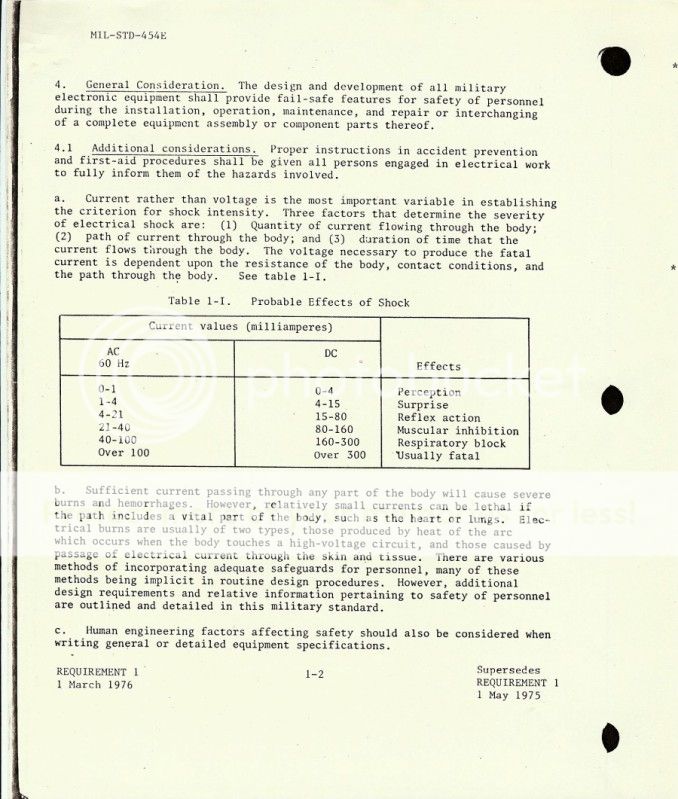A few days ago a gent asked a great question about why Polarized 120 VAC plugs/receptacles are used. (Forces one side to be the Hot, the other the Grounded Neutral) There were good answers and information posted but I dont think this one was??
A typical 120 VAC tool typically has an On Off switch which leads to a motor that has a ton of insulated (insulation can fail ya know) windings and then connections and splices etc before it wires back to where the cord enters the tool. When a short occurs, somewhere in all that maze of windings and splices etc., a live hot conductor could come in contact with the case (unless plastic and double insulated etc which many now are is less a hazard) that you hold in your hands and the hot wire is 120 VAC above Neutral which is tied to mother earth back at the main panel. And you may well be standing on mother earth or something else that is near that same potential, i.e. 120 volts between you hands and feet or other hand etc OUCHHHHHHHHHHHHHHHHHH.
If a polarized plug is used and alls wired correct, when the cord first enters that tool the very first thing is the On Off switch (on the HOT lead) and when off/open all else in the tool (windings n splices etc which may short out to case) is dead and de energized. HOWEVER if the polarized plug isnt used and its not plugged in or wired the correct way even with the switch off (assuming it then switches the Neutral not the Hot) ALL THOSE HOT LIVE WIRES WHICH COULD SHORT TO THE CASE ARE STILL ENERGIZED AT 120 VOLTS EVEN WHEN THE TOOL IS TURNED OFF.
So you can see why its safer if the first thing inside (the switch) i.e. the HOT WIRE is whats de energized so all the rest is dead. If the Neutral was whats broken by the switch opening, then all the rest of all those wires n windings n splices which could short to case n kill you WOULD STILL BE HOT...
Bottom line the UL and NEC are experts on all this electrical and fire safety and if a person follows their guidelines and uses tools they approve, theres a darn good chance their lives may be saved versus doing just the opposite cuz Billy Bob and his know it all Brother in Law Bubba (wired their own homes over a case of beer n all works fine) say they know better... IE I'll take my life chances with NEC and UL instead of Billy Bob, you do as yall please..
In the hopes yall keep SAFE
Ol John T
A typical 120 VAC tool typically has an On Off switch which leads to a motor that has a ton of insulated (insulation can fail ya know) windings and then connections and splices etc before it wires back to where the cord enters the tool. When a short occurs, somewhere in all that maze of windings and splices etc., a live hot conductor could come in contact with the case (unless plastic and double insulated etc which many now are is less a hazard) that you hold in your hands and the hot wire is 120 VAC above Neutral which is tied to mother earth back at the main panel. And you may well be standing on mother earth or something else that is near that same potential, i.e. 120 volts between you hands and feet or other hand etc OUCHHHHHHHHHHHHHHHHHH.
If a polarized plug is used and alls wired correct, when the cord first enters that tool the very first thing is the On Off switch (on the HOT lead) and when off/open all else in the tool (windings n splices etc which may short out to case) is dead and de energized. HOWEVER if the polarized plug isnt used and its not plugged in or wired the correct way even with the switch off (assuming it then switches the Neutral not the Hot) ALL THOSE HOT LIVE WIRES WHICH COULD SHORT TO THE CASE ARE STILL ENERGIZED AT 120 VOLTS EVEN WHEN THE TOOL IS TURNED OFF.
So you can see why its safer if the first thing inside (the switch) i.e. the HOT WIRE is whats de energized so all the rest is dead. If the Neutral was whats broken by the switch opening, then all the rest of all those wires n windings n splices which could short to case n kill you WOULD STILL BE HOT...
Bottom line the UL and NEC are experts on all this electrical and fire safety and if a person follows their guidelines and uses tools they approve, theres a darn good chance their lives may be saved versus doing just the opposite cuz Billy Bob and his know it all Brother in Law Bubba (wired their own homes over a case of beer n all works fine) say they know better... IE I'll take my life chances with NEC and UL instead of Billy Bob, you do as yall please..
In the hopes yall keep SAFE
Ol John T



